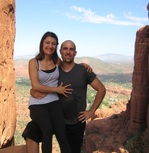I feel the crunch of glass beneath my feet. The echoes of voices wafting from the central chamber. The crumbling murals now decorate the floors as much as the walls. The air harkens back to a time of pride and memory but is singed with the heat of anger.
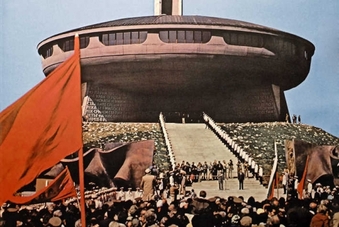
Buzludja in glory days
I am walking through the former House-Monument of the Bulgarian Communist Party, named now simply for the mountain upon which it perches - Buzludja. The construction for the monument was finished in 1981 as a 90 year commemoration to the meeting in 1891, where socialist revolutionaries met atop Buzludja to form the foundations of what would later become the Bulgarian Communist Party. But just as meaningfully, the monument was also meant to mark the 1300th anniversary of the foundation of the first Bulgarian Empire in 681 AD. At the time, the site cost a whopping 16 million levs to build (the equivalent of about $10 million dollars in 1980), much of it through “suggested” donations from the Bulgarian people. It took 6,000 workers 7 years to build, and involved 20 leading Bulgarian artists who worked for 18 months on the interior decoration. But after only 8 years as a functional monument, the end of communism in Bulgaria saw Buzludja turned over to the new state, where it was left to ruin by the elements and looters. In 2011, the monument was turned over to the Bulgarian Socialist Party, who promptly welded shut all the entrances, declaring it dangerous and unsafe to enter (which it is).
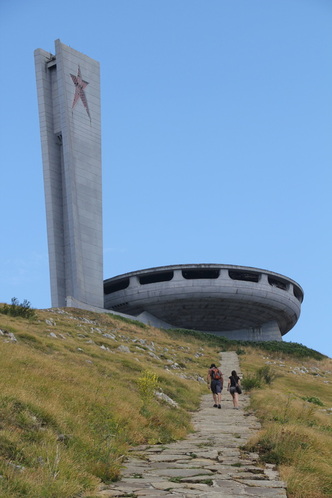
The approach to Buzludja
We visited Buzludja as part of a tour of Bulgaria for our friends
Brett & Christy, who we met in
Thailand. When you first arrive, you can’t help but be stunned by the site of the UFO-like monument perched above the mountain. Its remote location made it an architectural and engineering feat for any time period. Bulgarians tell stories about how at first prisoners were made to work on the monument, then the military joined in, and eventually many volunteers were inspired to help.
Abutting the main spherical chamber is a massive concrete tower with a 45 meter high red star embedded in the side. The star is 3x larger than the one at the Kremlin. It is said that when Buzludja was still operating and the star was lit, you could see it from many miles away…though all the electricity of constantly heating the building and lighting the star would often leave local villages in the dark.
The star was also rumored to be made of real rubies…a rumor proven untrue when after the fall of communism some people shot machine guns at the stars and received only ruby colored glass in return.
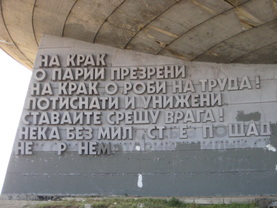
On your feet you slaves of labor...
On the street and next to the walking path leading up Buzludja, are two enormous sculpted hands holding torches, keeping guard over the monument. After you take the steep climb up the hill to the monument, you reach the square at the entrance to the building where the party would have held gatherings. Written in giant Cyrillic letters on either side of the doorway are the lyrics to the International Communist Hymn that was sung by communists of all nations during the time of Soviet rule.
That would have been it for our visit, but we were lucky enough to run into an intrepid individual who runs tours through Buzludja for visitors. He found an underground entrance near the building where, with the aid of a rope, one can repel down into the ruins. Despite our reservations, we were yearning to see this chapter of Bulgaria’s past, so we grabbed hold and followed them into the darkness….
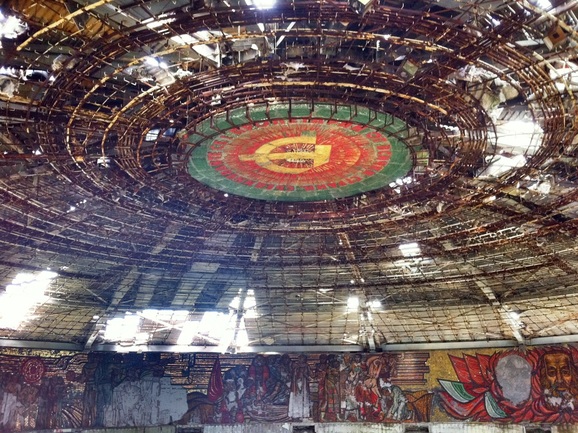
The central chamber of Buzludja now...
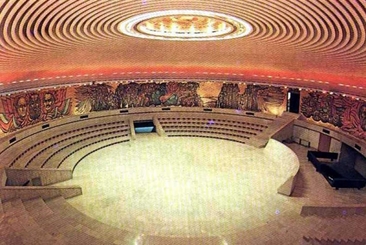
...and then.
Moving through dark corridors…the musky scent of dust and degradation. Climbing the steps towards the light and arriving to a scene of…utter grandeur. Despite the looting and elements, the central chamber of Buzludja is still an awe-inspiring one. The huge spherical chamber is covered in communist styled murals, culminating in a huge hammer and sickle at the ceiling surrounded by a call for the Proletariat in every country to unite. Little remains of the floor, which is said to have been pure marble, or the roof of the sphere, which is said to have consisted of over 30 tons of copper. But many of the murals, in varying states of decay, remain. Of particular note is the mural one sees just upon entering the main chamber. In the center is the face of Dimitar Blagoev, known as the founder of Bulgarian socialism. To his right is Georgi Dimitrov, an early Communitist politician who led Bulgaria from 1946 to 1949. But most interesting is the shadow of the image to the left. Here, the tiles of the face of Todor Zhivkov have been carefully removed, leaving only the outline of his visage. Zhivkov was the President for nearly the whole tenure of communism in Bulgaria – from 1954 to 1989. His missing face is a mystery – either removed by angry protestors after the fall or removed by the man himself when he no longer wanted to be connected to a fallen regime.
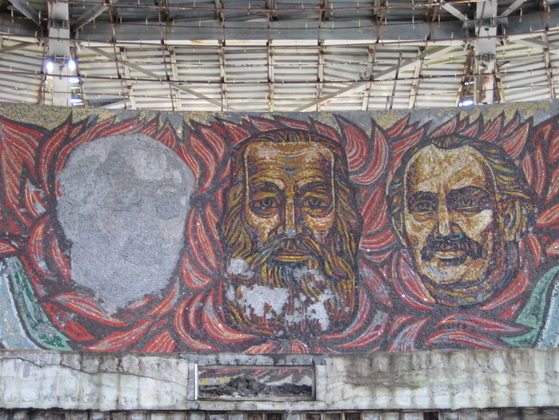
Dimitar Blagoev in center, Georgi Dimitrov at right, and the shadowy visage of Todor Zhivkov at left
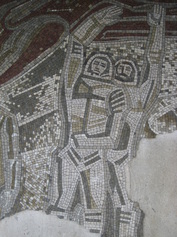
The astronauts
The murals are more than just communist leaders. Walking around the outer chamber with its Enterprise-like windows offering sweeping views of the surrounding area, there are celebrations of the Soviet astronauts who first entered space. There are murals commemorating the workers who built the monument. There is even a mural of a Slavic God (perhaps Pirin or Stopan) standing in the middle of the field as the Russian Army liberates (or invades based on your perspective) Bulgaria. Sadly, that last mural was in such a state of decay that it was barely recognizable – this picture from the old times shows what it once resembled.
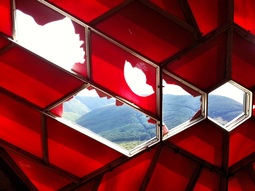
A view through the star
As we left the central chamber, we climbed the 10 stories of ladders in the dark to reach the top of the tower where the grand red star lies, still shattered from the gun fire of 20 years ago. The red light shining through the glass casts an eerie glow on the rusty equipment lying around. Sitting anachronistically on one floor was a modern spotlight, probably used by the Socialist party recently in commemoration of their founding. Finally, we emerged at the top of the tower where the stunning view of the countryside, the remains of the roof of Buzludja, and the hillside monument of Shipka takes one’s breath away.
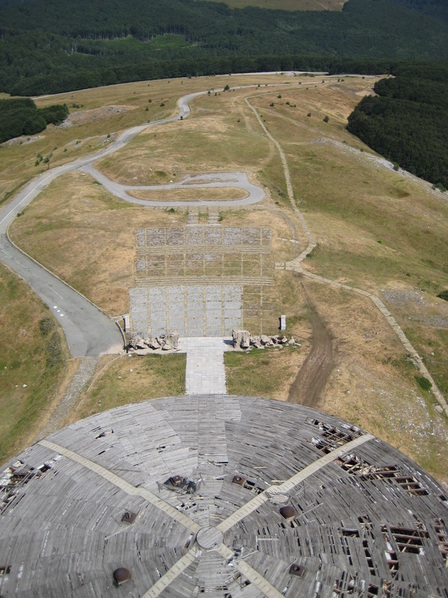
Atop the flag, the view of Buzluda's roof and the surrounding area...
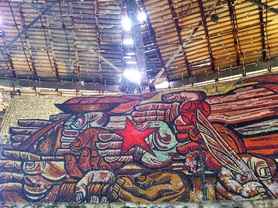
The state of Buzludja left Neda and me with mixed feelings. The site of this great architectural wonder of Bulgarian history being left to ruin filled us with sadness. As we moved through the abandoned halls, it brought to mind the lineage of teachers we are connected to in the Zen tradition. The lineage moves through our teacher, Barbara Kohn, through one of the founders of American Zen Buddishm, Shunryu Suzuki, and eventually down to the Buddha himself. In some ways it is strange for Zen, which focuses so much on the present moment, to emphase a lineage that flows backwards into the past. How do these concepts reconcile? For me, it is the understanding that even while living fully in the present moment, one is always affected and influenced by the stream of past actions. In the case of Buzludja, it felt like Bulgaria’s lineage had been broken. The time when communism dominated the country was a struggle for many ordinary citizens and left behind much resentment. At the same time, this period of history is still part of Bulgaria’s past and shapes who she is today. Should it be left to just fall apart?
In 2011, when Buzludja was returned to the Socialist Party in Bulgaria, Bulgaria’s Prime Minister Boyko Borisov said, “We shall let them take care of it because here it also holds true that a party which does not respect its past and its symbols has no future”.
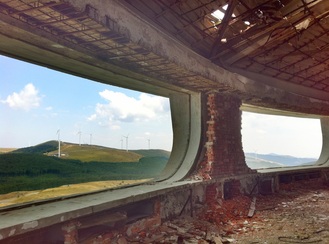
Through old windows, new wind turbines...
But is Buzludja only a symbol of the party? Or is it also a symbol of the millions of hours of work that went into constructing it by the Bulgarian people? Isn’t it the inheritance of every Bulgarian citizen to remember not only the pain of their people during this time, but also their spectacular workmanship? It is clear that there is interest. While we visited the site, a steady stream of Bulgarians and foreigners visited, though most were not able to enter the way that we did. Perhaps in some way Buzludja as a ruin presents more allure than it ever could have as a shiny tourist attraction. Perhaps it is the very degradation of the place that serves as such a powerful symbol. Rumors are circulating that the Socialist Party might try to renovate the building if the funds can be raised. It would be an auspicious task to undertake given Buzludja’s current condition, but perhaps it would help to restore a part of the country’s lineage that is being lost even as we speak.







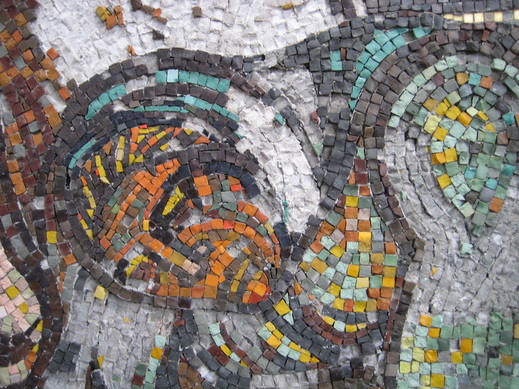

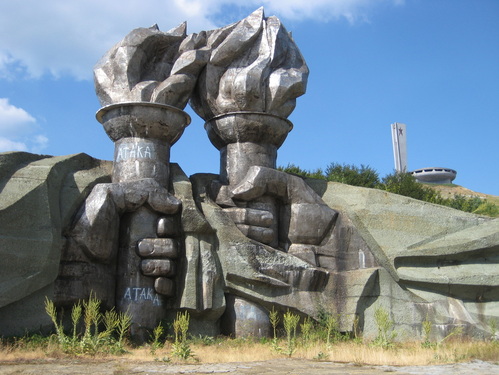


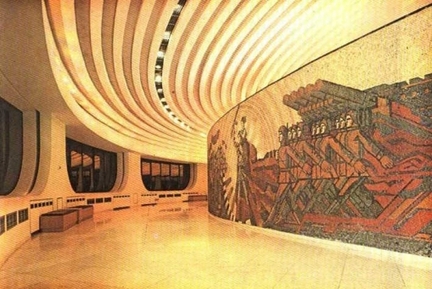

 RSS Feed
RSS Feed